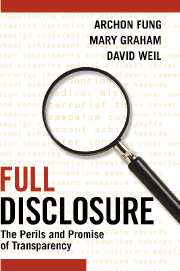Book contents
- Frontmatter
- Dediaction
- Contents
- List of Figures and Tables
- Preface
- 1 Governance by Transparency
- 2 An Unlikely Policy Innovation
- 3 Designing Transparency Policies
- 4 What Makes Transparency Work?
- 5 What Makes Transparency Sustainable?
- 6 International Transparency
- 7 Toward Collaborative Transparency
- 8 Targeted Transparency in the Information Age
- Appendix: EighteenMajor Cases
- Notes
- Bibliography
- Index
Appendix: EighteenMajor Cases
Published online by Cambridge University Press: 27 July 2009
- Frontmatter
- Dediaction
- Contents
- List of Figures and Tables
- Preface
- 1 Governance by Transparency
- 2 An Unlikely Policy Innovation
- 3 Designing Transparency Policies
- 4 What Makes Transparency Work?
- 5 What Makes Transparency Sustainable?
- 6 International Transparency
- 7 Toward Collaborative Transparency
- 8 Targeted Transparency in the Information Age
- Appendix: EighteenMajor Cases
- Notes
- Bibliography
- Index
Summary
This book is based on an analysis of fifteen major U.S. and three international transparency policies. This Appendix provides a summary of the legislative history, purpose, provisions, politics, and dynamics of each of these policies. We have categorized U.S. cases by two broad policy objectives: reducing risks to the public and improving the quality and fairness of critical services. The three international policies are described in the final portion of this Appendix.
Further detail on each of these cases and links to related materials are available at the Transparency Policy Project Web site: http://www.transparencypolicy.net/.
TARGETED TRANSPARENCY IN THE UNITED STATES
Reducing Risks to the Public
Disclosing Corporate Finances to Reduce Risks to Investors
Created as a response to crisis, the United States’ system of corporate financial disclosure was cobbled together in 1933 and 1934 as a pragmatic compromise. Millions of Americans were left holding worthless securities when the stock market crashed in October 1929. By 1932, the value of stocks listed on the New York Stock Exchange had fallen by 83 percent. Congressional hearings revealed patterns of inflated earnings, insider trading, and secret deals by J. P. Morgan, National City, and other banks, hidden practices that contributed to the precipitous decline of public confidence in securities markets. Echoing Louis D. Brandeis's declaration that “sunlight is … the best disinfectant,” Franklin D. Roosevelt, the nation's newly elected president, championed legislation to expose financial practices to public scrutiny.
The Securities and Exchange Acts of 1933 and 1934 required that publicly traded companies disclose information about their finances in standardized form in quarterly and annual reports. Congress also authorized the newly created Securities and Exchange Commission (SEC) to issue uniform accounting standards for company financial disclosures. To gain support for a workable compromise, the disclosure requirements excluded banks, railroads, and many companies. Felix Frankfurter, Roosevelt's senior adviser on the legislation, called the Securities Act a “modest first installment” in protecting the public from hidden risks.
Later crises strengthened disclosure requirements. In the 1960s, the scope of disclosure was broadened when an unprecedented wave of conglomerate mergers followed by a sudden collapse of their stock prices created pressures for better information. Congress responded in 1968 with the Williams Act, which required disclosure of cash tender offers that would change ownership of more than 10 percent of company stock; Congress strengthened the law two years later by lowering the threshold for reporting to 5 percent and adding disclosure of product-line data.
- Type
- Chapter
- Information
- Full DisclosureThe Perils and Promise of Transparency, pp. 183 - 216Publisher: Cambridge University PressPrint publication year: 2007
- Creative Commons
- This content is Open Access and distributed under the terms of the Creative Commons Attribution licence CC-BY-NC 4.0 https://creativecommons.org/cclicenses/



